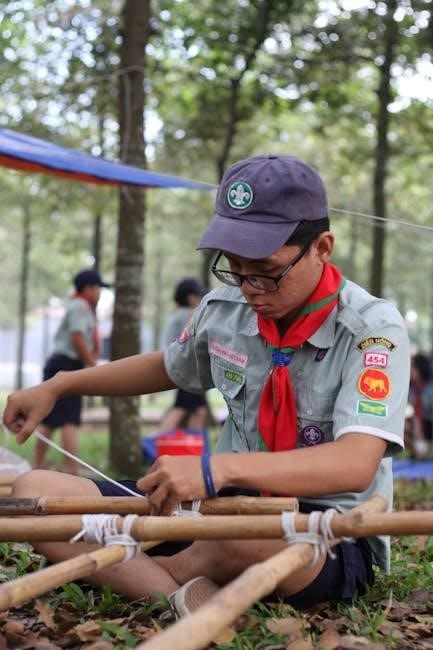rope bondage tutorial
Summary
Learn the art of rope bondage with our comprehensive tutorial guide. Discover step-by-step techniques, safety tips, and expert advice for beginners and advanced practitioners.

Rope bondage is a creative and consensual practice that combines elements of bondage and discipline, offering empowerment, trust, and intimacy. It’s a versatile art form with historical roots, used for connection, aesthetic expression, and sensory exploration. Beginners can start with simple knots and techniques, gradually mastering more complex ties while prioritizing safety and communication. This practice fosters emotional and physical closeness, making it a rewarding journey for those who explore it with curiosity and respect.
1.1 What is Rope Bondage?
Rope bondage is a consensual practice involving the use of ropes to tie, restrain, or create decorative patterns on the body. It is a form of BDSM (Bondage/Discipline/Dominance/Submission/Sadism/Masochism) that emphasizes trust, communication, and power dynamics. This art form, also known as shibari or kinbaku, combines functional restraint with aesthetic appeal. Rope bondage can range from simple wrist ties to intricate full-body harnesses, serving both practical and symbolic purposes. It fosters emotional connection and empowerment, making it a popular and versatile activity for those exploring kinks and intimacy. Consent and safety are paramount, ensuring a positive and enjoyable experience for all participants.
1.2 Brief History of Rope Bondage
Rope bondage has deep roots in history, particularly in Japanese culture, where practices like shibari and kinbaku emerged. These forms, dating back centuries, were initially used in rituals and ceremonies, blending functional restraint with aesthetic appeal. Over time, rope bondage evolved into a global phenomenon, blending with BDSM practices. It has become a popular form of artistic expression, emphasizing trust, power dynamics, and emotional connection. Today, rope bondage is celebrated for its versatility, ranging from decorative ties to intimate restraints, making it a cornerstone of modern kink culture and a symbol of consensual exploration and empowerment.
1.3 Benefits of Learning Rope Bondage
Learning rope bondage offers numerous benefits, enhancing trust, communication, and intimacy between partners. It fosters creativity and self-expression, allowing practitioners to explore power dynamics safely. Rope bondage can also improve focus and patience, as it requires precision and attention to detail. For many, it becomes a meditative practice, promoting mindfulness and connection. Additionally, mastering rope techniques builds confidence and skill, which can translate into other areas of life. Whether for artistic expression or personal growth, rope bondage provides a unique way to deepen relationships and explore new dimensions of emotional and physical connection.

Safety Considerations
Prioritizing safety is crucial in rope bondage to ensure physical and emotional well-being. Awareness of risks, proper techniques, and a prepared environment are essential for a safe experience.
2.1 Health and Safety Precautions
Ensuring health and safety is paramount in rope bondage. Always assess medical conditions, as certain ailments like poor circulation or joint issues may pose risks. Use high-quality ropes made from natural fibers like cotton or hemp, as synthetic materials can cause discomfort. Avoid tight knots that restrict blood flow, and regularly monitor the bound individual for signs of distress, such as numbness or discoloration. Immediate action, like loosening ropes, is crucial if discomfort arises. Open communication between participants is essential to address concerns promptly. Keep safety tools, such as scissors, nearby for emergencies. Prioritize health and well-being to ensure a safe and enjoyable experience.
2.2 Importance of Consent
Consent is the foundation of rope bondage, ensuring all parties willingly and knowingly participate. It must be explicit, enthusiastic, and ongoing, with clear communication of boundaries and desires. Both the person tying and being tied must agree to the activity, understanding their roles and limits. Safe words or signals are essential to halt the session if discomfort arises. Respect and trust are vital, as consent can be withdrawn at any time. Never assume consent; it must be actively given and reaffirmed. Open dialogue fosters a safe and enjoyable experience, ensuring mutual respect and understanding. Consent is non-negotiable and must be prioritized above all else.
2.3 Setting Up a Safe Environment
Creating a safe environment for rope bondage is crucial for a positive experience. Choose a quiet, private space with a comfortable temperature and soft flooring, like a mattress, to prevent injury from falls. Ensure the area is free from sharp objects, fragile items, and tripping hazards. Good lighting is essential to see details clearly. Have a first aid kit nearby and ensure easy access to communication tools. Establish a safe word or signal before starting. Participants should be sober and in a stable mental state. A calm and respectful atmosphere reduces anxiety, fostering trust and focus. Preparation and awareness are key to ensuring safety and enjoyment for all involved;
Materials and Tools
Rope bondage requires high-quality materials. Common ropes include jute, hemp, and nylon, each offering different textures and durability. Essential tools like scissors, safety knives, and gloves ensure safety and ease. Proper rope care, such as washing and conditioning, extends lifespan. Additional items like wax or lubricants can enhance performance. Investing in the right materials and tools is vital for effective and enjoyable rope bondage practices.
3.1 Types of Ropes for Bondage
Rope bondage utilizes various materials, each with unique properties. Natural fibers like jute and hemp are popular for their grip and texture, making them ideal for bondage. Cotton ropes are soft and gentle, suitable for beginners or sensitive skin. Synthetic options, such as nylon or polyester, offer durability and easy cleaning. Silk or bamboo ropes provide a luxurious feel, often used for aesthetic ties. The choice of rope depends on personal preference, the intended technique, and the desired sensory experience. Proper care, like washing and conditioning, ensures longevity. Always prioritize quality and safety when selecting ropes for bondage practices.
3.2 Essential Tools for Rope Bondage
Beyond ropes, several tools enhance rope bondage safety and efficiency. Safety scissors are crucial for quick rope cutting in emergencies. A blindfold can heighten sensory experiences, while a gag may be used for verbal restriction. A rope cutter or knife is handy for trimming ropes. Quick-release knots are vital for easy untying. Soft padding, like cloth, prevents chafing. Lubrication reduces friction on skin. These tools, along with proper techniques, ensure a safe and enjoyable experience. Always prioritize quality and functionality when selecting tools for rope bondage practices.

Basic Knots for Beginners
Mastering basic knots like the square knot and clove hitch is essential. These foundational ties ensure safety and reliability, building confidence for more complex techniques.
4.1 Essential Knots Every Beginner Should Know
Start with the square knot, a simple yet secure tie for binding two ends. The clove hitch is perfect for securing ropes to objects. The lark’s head knot creates a loop for quick attachments. The half hitch extends or tightens bonds, while the overhand knot prevents fraying. These knots form the foundation of rope bondage, ensuring safety and control. Practice them regularly to build muscle memory and confidence. Understanding these basics will allow you to progress to more complex techniques seamlessly. Always prioritize neatness and tension to avoid discomfort or slippage during sessions.
4.2 Step-by-Step Guide to Tying Basic Knots
Start by holding the rope in both hands, ensuring it’s folded evenly. For the square knot, cross one end over the other, loop it under, and pull tight. The clove hitch begins with a wrap around an object, then crosses over itself to secure. The lark’s head involves folding the rope in half and looping it around the anchor point. Practice each knot slowly, focusing on tension and neatness. Always tie knots on a willing partner to ensure comfort and safety. Regular practice will improve your speed and accuracy, building a strong foundation for more intricate ties.

Techniques for Different Body Parts
Explore various tying methods for wrists, ankles, chest, and torso. Learn full-body ties and position-specific techniques. Emphasize safety, comfort, and aesthetic appeal in every bondage application.
5.1 Wrist and Ankle Bondage Techniques
Wrist and ankle bondage is a popular starting point for beginners. It involves securing limbs using ropes, often in a non-elastic material like cotton or nylon. The single column tie is a foundational technique, wrapping rope around the wrist or ankle in a figure-eight pattern. For added stability, the double column tie can be used, creating two parallel wraps. Always ensure the ropes are snug but not overly tight to avoid circulation issues. Keeping the limbs slightly flexed can help prevent nerve pinching. Practice these techniques slowly and communicate with your partner to ensure comfort and safety. Regularly check circulation for prolonged sessions.

5.2 Chest and Torso Bondage Techniques
Chest and torso bondage involves securing the upper body, enhancing control and intimacy. The over-the-shoulder tie is a common method, wrapping ropes around the chest and shoulders to create a secure hold. Another technique is the around-the-chest tie, which encircles the torso, often incorporating the arms for added restraint. Using wider ropes or multiple passes ensures even pressure distribution. Safety is critical; avoid tight bindings that restrict breathing. Regularly check circulation and adjust as needed. Communication with your partner is key to ensure comfort and safety; These techniques can be combined with others for more complex binds, offering versatility in rope play scenarios.
5.3 Full-Body Bondage Techniques
Full-body bondage involves intricate techniques to restrain the entire body, requiring skill and attention to detail. One popular method is the frog tie, where the legs are bent and tied together, while the arms are secured behind the back. Another advanced technique is the strappado, combining arm and shoulder bindings for enhanced control. Using multiple ropes interconnected across the body ensures maximum immobilization while maintaining safety. Proper circulation and breathing must be monitored closely. Full-body binds often blend functionality with aesthetics, creating visually striking patterns. Practitioners should approach these techniques with patience and prioritize clear communication to ensure a safe, enjoyable experience for all involved.
5.4 Bondage for Specific Positions
Bondage for specific positions enhances creativity and control during scenes. Standing bondage often involves securing wrists to a structure or each other, while seated bondage uses chairs or benches to immobilize the body. Lying-down positions, like the spread eagle, require securing limbs to bedposts or anchor points. Suspension bondage, though advanced, offers unique experiences by lifting the body partially or fully off the ground. Each position demands tailored techniques to ensure comfort and safety. Communication is key to adapt bindings according to the participant’s tolerance and physical limits. Proper support and circulation checks are essential to prevent discomfort or injury during extended sessions.

Intermediate Techniques
Intermediate techniques involve mastering advanced knots and patterns, combining elements for intricate bonds, and refining efficiency and control for dynamic rope work.
6.1 Advanced Knots and Patterns
Advanced knots and patterns are essential for creating intricate and visually appealing bondage designs. Techniques like the Lark’s Head, Water Knot, and Dragon Loop offer versatility. Practicing these knots enhances precision and speed, while patterns such as the Chest Harness or Bamboo Tie add complexity. Combining knots into seamless flows creates dynamic and stable bonds. Symmetry and tension control are key for both functionality and aesthetics. These skills allow for more creative expression and confidence in rope work, transitioning from basic restraining ties to artistic expressions. Mastery of advanced knots and patterns is a cornerstone of intermediate rope bondage, enabling practitioners to explore more sophisticated techniques.
6.2 Combining Multiple Ropes
Combining multiple ropes allows for more complex and secure bondage designs. Techniques like rope weaving and layering enable seamless integration. Practitioners can create intricate patterns by alternating ropes or using them for different purposes. This method enhances control and symmetry while maintaining comfort. Tips include planning the rope lengths and transitions in advance. Managing multiple ropes requires attention to avoid tangles or uneven tension. Efficiently switching between ropes ensures fluidity in the session. This skill expands creative possibilities and builds confidence in handling more dynamic bondage scenarios. Mastering multiple rope combinations is a key step in advancing rope bondage skills.
6.3 Creating Aesthetically Pleasing Bonds
Creating aesthetically pleasing bonds involves attention to detail and artistic expression. Symmetry, clean lines, and balanced patterns enhance visual appeal. Practitioners often use techniques like looping, weaving, or coiling ropes to create decorative effects. Contrasting rope colors or textures can add visual interest. Properly tensioned knots and smooth rope placement prevent unsightly twists or overlaps. Aesthetics also depend on how the ropes complement the body’s shape. While functionality remains key, focusing on beauty can elevate the experience. Taking time to adjust and refine the bondage ensures both safety and visual satisfaction. This step transforms rope bondage into a form of artistic expression.

Advanced Techniques
Advanced techniques in rope bondage involve complex patterns, dynamic ties, and precision. These methods require mastery of basic skills and focus on safety, creativity, and control;
7.1 Suspension Bondage Basics
Suspension bondage is an advanced technique where the bottom is partially or fully lifted off the ground using ropes. It requires extreme caution, proper equipment, and a solid understanding of rope dynamics. Always use sturdy suspension points and ensure the ropes are secured correctly to avoid accidents. Communication is key; the bottom should be able to signal discomfort or distress immediately. Start with low suspension to build trust and confidence. Never leave the bottom unattended, and have a plan for emergencies. Suspension bondage can be deeply intense but also risky, so prioritize safety and aftercare to ensure a positive experience for all involved.
7.2 Dynamic and Decorative Ties
Dynamic and decorative ties combine artistry with functionality, creating visually appealing bonds that enhance the rope bondage experience. These ties often incorporate intricate patterns, knots, and twists to add aesthetic value while maintaining structural integrity. They allow for fluid movement and can be adjusted to accommodate different positions or moods. Decorative elements like wraps, weaves, and ornamental knots can elevate the session’s intensity and intimacy. Communication and consent are crucial, ensuring both parties are comfortable with the design and tension. Practice these techniques to master the balance between beauty and safety, making each tie a unique expression of connection and creativity.

Common Mistakes to Avoid
Common mistakes include using too tight ropes, not checking circulation, ignoring consent, and rushing the process. Avoid these to ensure a safe and enjoyable experience.
8.1 Rookie Mistakes in Rope Bondage
One of the most common rookie mistakes is using ropes that are too tight, which can restrict circulation. Always check for proper blood flow and nerve sensation. Another error is not monitoring the bottom’s comfort levels, leading to numbness or tingling. Ignoring consent or rushing the process is also a major oversight. Beginners often forget to use the right knots, causing difficulty in releasing the ties quickly. Additionally, using unsuitable materials or improper rope lengths can lead to discomfort. Lastly, poor communication and not regularly checking in with your partner can create unnecessary anxiety. Practice patience and awareness to avoid these pitfalls.
8.2 How to Troubleshoot Common Issues
When encountering issues during rope bondage, remain calm and address them methodically. If ropes are too tight, gently loosen them to restore circulation. For stubborn knots, use a blade or scissors as a last resort. Ensure open communication with your partner, checking in regularly to assess comfort and needs. If numbness occurs, release the ropes temporarily to allow blood flow. Adjust your technique to avoid pressure points and improve stability; Practice knot-tying separately to build confidence. Stay patient and proactive, focusing on safety and mutual enjoyment. Troubleshooting effectively enhances trust and ensures a positive experience for both participants.

Aftercare and Communication
Aftercare involves physical and emotional support post-session, ensuring comfort and connection. Open communication fosters trust, allowing both parties to share feedback and feelings, enhancing the overall experience.
9.1 The Importance of Aftercare
Aftercare is a critical component of rope bondage, ensuring physical and emotional well-being post-session. It involves checking in with your partner, addressing any discomfort, and providing reassurance. This practice helps prevent physical issues like numbness or bruising while fostering emotional connection. Aftercare strengthens trust and intimacy, allowing both participants to decompress and reflect on their experience. It also helps manage any emotional drop that may occur after intense play. By prioritizing aftercare, you create a safe and caring environment, ensuring a positive and fulfilling experience for everyone involved.
9.2 Effective Communication During Sessions
Effective communication is vital during rope bondage sessions to ensure safety, consent, and a positive experience. Clear dialogue helps both participants stay aligned, addressing needs and boundaries. Verbal cues, such as safe words, allow for immediate adjustments or pauses. Non-verbal signals, like hand gestures, can also be used to check in. Active listening and empathy foster trust and understanding. Regular check-ins prevent discomfort or distress, while open feedback enhances the session’s quality. Communication strengthens the bond between partners, ensuring a respectful and enjoyable experience. It’s essential to maintain awareness of each other’s comfort levels throughout the process.

Resources and Communities
Explore recommended books, tutorials, and online communities for rope bondage. Engage with forums, workshops, and classes to enhance your skills and connect with enthusiasts.
10.1 Recommended Books and Tutorials
For mastering rope bondage, several books and tutorials are highly recommended. Titles like The New Topping Book and The New Bottoming Book by Dossie Easton and Janet Hardy provide comprehensive insights. Rope Bondage: The Essential Guide by Lee Harrington is another excellent resource; Online platforms like FetLife and RopeBondage.com offer detailed tutorials and videos. YouTube channels dedicated to rope bondage also share step-by-step guides, focusing on safety and technique. These resources cater to both beginners and advanced practitioners, ensuring a well-rounded understanding of the art. Combining these with hands-on practice under experienced guidance will enhance your proficiency in rope bondage.
10.2 Online Communities and Forums
Online communities and forums are invaluable for learning and mastering rope bondage. FetLife, a popular BDSM social network, hosts groups dedicated to rope bondage, offering tutorials, discussions, and resources. Reddit’s r/ropebondage and r/bdsm communities provide extensive guides, videos, and step-by-step instructions. These platforms allow interaction with experienced practitioners, enabling learners to ask questions and share experiences. Many forums also emphasize safety and etiquette, ensuring a supportive environment. By engaging with these communities, enthusiasts can access a wealth of knowledge, stay updated on trends, and connect with like-minded individuals. These online spaces are essential for both beginners and advanced practitioners seeking to refine their skills.
10.3 Workshops and Classes
Workshops and classes are excellent ways to gain hands-on experience in rope bondage. Many BDSM events and dungeons offer in-person sessions, where experienced instructors demonstrate techniques, safety practices, and creative ties. These classes provide personalized feedback, helping learners improve quickly. Workshops often cater to all skill levels, from basics to advanced techniques. They also foster a sense of community, allowing participants to network with other enthusiasts. Additionally, some workshops focus on specific styles, such as Japanese rope bondage or suspension techniques. Attending these sessions ensures a safe and immersive learning environment, making them a valuable resource for mastering rope bondage effectively.
Mastering rope bondage requires patience, practice, and dedication. Through consistent effort, you’ll unlock creativity and confidence in your ties, enhancing your skills over time.
11.1 Final Thoughts on Mastering Rope Bondage
Mastering rope bondage is a journey that requires patience, creativity, and practice. It’s essential to always prioritize safety, consent, and open communication. As you progress, you’ll not only refine your technical skills but also deepen the emotional connection with your partner. Remember, rope bondage is both an art and a form of intimacy. Embrace the process, stay curious, and continuously explore new techniques. With dedication, you’ll unlock the full potential of this transformative practice, creating meaningful and memorable experiences.
11.2 Encouragement to Keep Practicing
Keep practicing rope bondage with enthusiasm and dedication. Every session is an opportunity to refine your skills and deepen your connection with your partner. Celebrate small victories, like mastering a new knot or perfecting a technique. Remember, improvement takes time, and consistency is key. Don’t be discouraged by setbacks—each challenge is a chance to learn and grow. Embrace the journey, stay open to feedback, and enjoy the creative process. With patience and persistence, you’ll unlock new possibilities and continue to enhance your skills. Keep exploring, and most importantly, have fun while doing it!